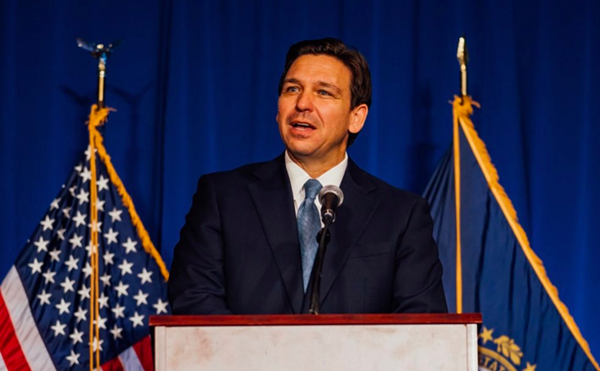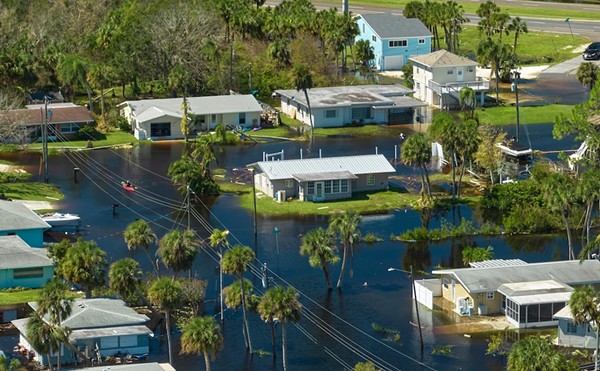Next week's cassini launch from Cape Canaveral is only the start of the nuclear assault on space.
You'd think a guy with two houses in Florida would be chipper. But Horst Poehler is not. Poehler is lamenting a lost opportunity. An opportunity to matter. An opportunity, perhaps, to change the course of U.S. space policy and -- not coincidentally -- keep radiation from raining down on his houses.
Horst Poehler wanted to say some things about NASA's Cassini mission. Science things. Poehler says his former colleagues, who plan to launch the Cassini probe to Saturn on Oct. 13, have their collective heads up their nozzles, and he has the proof. "I could have nailed them to the wall," he says, pacing in his back yard 20 miles from Kennedy Space Center.
Cassini is potentially the most hazardous mission NASA has ever flown, carrying 72.3 pounds of plutonium 238 in three nuclear batteries that will provide electricity for the 18 instruments on the spacecraft. The cargo has caused controversy, mostly fueled by the efforts of Bruce Gagnon, of the Gainesville-based Florida Coalition for Peace and Justice, and Karl Grossman, a New York journalism professor with anti-nuclear leanings who wrote a book on the matter, titled "The Wrong Stuff."
Poehler is lamenting that Gagnon did not give him a place at the podium during a debate last month with flacks from NASA, the Air Force and the Department of Energy. "They made this a political debate," says Poehler, who for 25 years served as a NASA contractor, retiring in 1985 with the title "chief scientist." He says "political" the way some people say "malignant cyst."
Poehler did make some observations to the capacity crowd convened by Florida Today newspaper. "I think the whole thing is outrageous! If it's so safe, why can't it be encased on a plane legally?" he demanded. "They blew it up and the whole thing disappeared! What about that?"
"Please sit down, sir," the emcee advised. Poehler reluctantly did.
The argument against Cassini boils down to this: NASA's own documents say significant plutonium would be released during any of several accident scenarios, but the space agency discounts the probability of such an accident, as well as the possibility that a plutonium release actually would harm anyone. NASA uses pretty good methodology to determine the circumstances under which plutonium would get loose (the discounted explosion test notwithstanding), but the space agency's claim that virtually no one would be harmed is based on old and controversial -- if not totally discredited -- science. And its odds-making is make believe.
"The one-in-a-million `chance of an accident` is wishful thinking masquerading as reputable science," says Dr. Michio Kaku, who has published a critique of NASA's risk analysis.
Poehler goes further, calling his former NASA colleagues "mad scientists."
Right. What's next? They're going to rule the world? Take over the galaxy?
Here's the funny part: Yes.
When Poehler yells "they blew it up and the whole thing disappeared!," he elicits the same rolling of the eyes as a Revelations-obsessed street preacher. The fact that NASA actually did test a nuclear battery in an explosion, which really did annihilate the battery, and then really did throw out the results and declare that they used too much explosive ... well, by the time you're deep enough into NASA's Environmental Impact Statement to discover this, you've already crossed some kind of psychogeek chasm, and the people on the other side can no longer hear your screams. The Cassini debate is being waged among people who have read this stuff. These people already know that NASA and the U.S. Air Force plan to launch nuclear reactors on nuclear rockets, to mine helium-3 from moon dust, to make fusion power reactors, which will allow Man to subdue the cosmos and make William Shatner seem -- impossibly -- more the visionary than he already does.
They already know that the future of space -- like the future of everything -- is privatized, Disneyfied and indemnified against catastrophic liability by tort reform and peculiar insurance laws. They know the Price Anderson Act limits U.S. liability in the event of a nuclear accident to $8.9 billion, and just $100 million for damage to people and property outside the United States.
Among these cognoscenti, most think atomic space colonies are America's Manifest Destiny, and that no expense should be spared and no risk is too great to pull it off. Grossman, Gagnon, Poehler et al. represent a small fringe element: people who understand this stuff and think, "Good Christ! These are mad scientists! They're gonna kill us all to feed their megalomaniacal dreams of world domination!"
Gagnon announces regularly that the Cassini mission is an "icebreaker" designed to soften up the public for future nuclear missions. He displays two lavishly-illustrated brochures from the Air Force Space Command, "Guardians of the High Frontier" and "Vision for 2020," which set out a plan for space dominance in the next century. During the Florida Today debate, Air Force Col. Everett Thomas waited for Gagnon to finish and said, "I fail to see any connection between what was said there and the Cassini mission."
Added Department of Energy spokeswoman Beverly Cook: "I have no orders from anybody ... for space `nuclear` reactors. Lots of people write lots of plans." Ho hum.
So how dangerous is Cassini? And how much of a crackpot is Gagnon? It is instructive to consider the arguments of the space boosters and visionaries who comprise the National Space Society, a 27,000-member association of space enthusiasts with 80 chapters. NSS often criticizes NASA's timidity and lack of vision, and counts among its ranks scientists, engineers and ex-astronauts. The group also stages counter-demonstrations to blunt Gagnon's attack. One Orlando member, Franklin Ratliff, has made it his solemn business to question Gagnon and other naysayers, even arguing at length the qualifications of Dr. Kaku to second-guess NASA's risk assessment.
Kaku graduated summa cum laude from Harvard, Phi Beta Kappa, and No. 1 in his physics class in 1968. He earned his Ph.D. at the University of California at Berkeley Radiation Lab in 1972, and is now a professor of theoretical physics at the Graduate Center of the City University of New York and a Fellow of the American Physical Society. He is a leading authority on Einstein's Unified Field Theory and the co-founder of string field theory, an esoteric branch of quantum physics. Statistically, he is a member of the limited fraternity of people with a valid chance of winning a Nobel Prize.
His challenger, Ratliff, has a bachelor's degree in journalism and works as a technical writer. He is currently at work on a "land speed record" car, the prototype of which is powered by a 50-horsepower Volkswagen engine and a wood propeller. He keeps as a handy reference a book called "The Future of Flight," copyrighted in 1968.
Clearly, theirs is a mismatched debate. But Ratliff is unrelenting, and in a letter last month to Kaku he demanded, "I also would like to know what Grossman, Gagnon, and you think will happen when manned spaceflight technology hits the brickwall limitations of chemical rockets ...." (Ratliff has more recently advocated ion propulsion.) Kaku has not responded.
"Chemical rockets have some pretty severe limitations," Ratliff says. And a rudimentary nuclear engine would provide twice the boost currently offered by a shuttle rocket, he adds.
Ratliff's notions are not just rosy residue from the go-go Apollo era, when nuclear power was marketed as "too cheap to meter." Robert Zubrin, chairman of the executive committee of the National Space Society and inventor, in the late 1980s when he worked for Martin Marietta (now Lockheed Martin), of a manned exploration program called "Mars Direct," says, "Of `the` seven major sources of humanity's power, only one, nuclear, can work in space."
Guys like Ratliff and Zubrin are pretty straightforward about this stuff. NASA is not. Last spring NASA officials sought to allay fears on the Cape Canaveral City Council by telling them that Cassini would be the last nuclear payload NASA launches. Gagnon arrived the next day with a NASA timetable from the DOE indicating the agency then planned 12 more nuclear launches before 2009. Included were the launch of two nuclear power plants to Mars on separate missions in 2007.
President Clinton must give final launch authority to Cassini and, perhaps feeling pressure, is giving the matter extraordinary attention. But last year Clinton, for the first time, made nuclear-powered "Star Wars" missile defense and a renewed quest for nuclear-powered rockets official U.S. space policy. And he has left at more than $30 billion the federal government's "black," or secret, budget, most of which is spent by the Air Force, which has convinced military and civilian policy makers that seizing the "high ground" of space with high-tech weapons makes more sense than investing in old-fashioned things like soldiers.
Only since the Gulf War has the U.S. Space Command come out of the closet with its plans for "space dominance." And although the weapons and tactics are no longer secret, the details have been relegated to publications like Space News, the NSS publication Ad Astra, and Aviation Week & Space Technology. There has been no public debate.
Which is why Lt. Col. Thomas can fold his hands and "fail to see any connection" between Cassini and Dr. Strangelove, and not be treated like a drunk stripper at a Lutheran wedding. Thomas knows the Defense Special Weapons Agency is in charge of developing nuclear rockets for Star Wars missile defense. Col. Thomas knows that until July of last year it was called the Defense Nuclear Agency. DOE spokesman Cook knows it too, because DOE helps NASA and the Air Force coordinate nuclear research.
Each year they stage the Space Technology & Applications International Forum in Albuquerque, N.M.; the next one is in January. The conference is sponsored, as usual, by the Defense Special Weapons Agency, the DOE, the Air Force and, yes, NASA. Among the symposiums will be the 15th annual one on space nuclear power and propulsion. The program co-chairman is William J. Emrich, senior engineer with NASA's Marshall Space Flight Center.
"We're looking at new ways of making propulsion with nuclear reactors," says Emrich, whose Alabama lab has a $3 million budget. "To do any sort of deep space exploration with people, you need to have a nuclear sort of system ... `A` chemical system doesn't have the energy to do the job."
Emrich's lab divides its attention among projects ranging from relatively mundane ceramic core fission reactors -- he says he's "trying to resurrect a small, more friendly version of the NERVA" rockets NASA tested in the late 1960s -- to an anti-matter machine. Antimatter is atoms whose polarities have been reversed; when they meet regular atoms, they disappear in a flash of gamma rays. The energy released is orders of magnitude greater than that of a hydrogen bomb. A teaspoon of anti-water dropped into Lake Apopka, for example, would blow out a divot from Mount Dora to Bithlo. Emrich says don't worry, though, the amount of antimatter he hopes to work with "wouldn't bury the U.S.; it would destroy the machine."
Theoretical mishaps with antimatter notwithstanding, Emrich acknowledges the public relations pitfalls of his line of work. "The problem is, they fired the NERVA rockets right into the atmosphere," he says. "They couldn't do that today. You say you're exhausting a nuclear rocket into the atmosphere, and everyone goes bananas about it." Yet he says a nuclear reactor, or even an atomic rocket, is safer than Cassini.
"We envision launching these `reactors` into space before they get turned on ... You could hold the fuel in your hands before it reacts. It's not terribly radioactive." Plutonium 238, by contrast, is extraordinarily hot. The radioactivity inside Cassini's three nuclear batteries is almost equal to the radiation released in every open-air nuclear bomb test conducted on Earth combined.
While NASA and the Air Force work on their plans for space dominance, others hope to use the technology for commercial dominance. A 1990 paper written for the Federal Aviation Administration's Office of Commercial Space Transportation outlines the system for safety review in the event a commercial launch (rather than military or NASA) involves a nuclear payload. The idea is to pave a regulatory path that will appear routine to any who might otherwise be alarmed by the prospect of private nukes in space, which could be used to help give you more TV channels in your dish, or provide hyper-powerful Internet access, real-time video conferencing and other Jetsons-type stuff.
And yet the report, by SRS Technologies of Huntsville, Ala., explicitly considers the political ramifications, even mentioning (albeit not by name) the Florida Coalition's attempts to stop the plutonium-equipped Galileo probe in 1989. "This protest was the first attempt by a citizen's group to stop a NASA launch by instituting legal proceedings," the report concludes. "But the incident may indicate a growing public propensity to protest against the launch of major nuclear sources."
With NASA's encouragement, a company called SpaceDev is planning to be the first to mine a near-Earth asteroid for valuable minerals, and has announced the design of its "prospector" space craft with a launch date sometime in 2000. The Japanese are seriously contemplating a moon mining operation.
The trouble with all this is it's against the law. Since 1967, space treaties bar weapons from space and prohibit nations from staking out territorial claims. But a Colorado non-profit called United Societies in Space has proposed a "Lunar Economic Development Authority" and even hopes to found a space-based "nation" in a few years to overturn or contravene the treaties.
The idea is to let rich folks stake their claim in return for profit, which will spur more investment and soon colonization. Again, the societies' members are aware of the implications. "The terms 'exploitation' and 'colonization' were singled out as counterproductive and inflammatory in much of the world," Michael Simon, president of International Space Enterprises and a NASA contractor, wrote in a report about an NSS meeting last year. "Discussions such as these are important so that we can focus or even change our message in order to achieve our ultimate goals."
In the July/August Ad Astra, Alan Wasser, an NSS board member, proposes a new U.S. law explicitly promoting a moon colonies. "Such legislation might pass as a minor revision of property law, without much publicity, which is probably best," he writes. "Passage of the legislation proposed here would quickly cure the 'giggle factor' associated with off-planet real estate deals."
Horst Poehler, critiquing Cassini from his Space Coast retirement home, isn't laughing. "We never knew about the plutonium in those things when I worked there," he says. "They didn't tell anyone. Nobody knew."
Franklin Ratliff isn't giggling either, even if he does harbor some secret hope of retiring to a terra-formed dome on the shores of the Sea of Tranquillity. "I think that ultimately everything is engineerable," he says, "given enough time and money ... whether it's building a land-speed car in your garage or launching a `nuclear`-powered spacecraft." As to whether Cassini, Star Wars, nuclear rockets and anti-matter shipped via UPS is worth the risk, this is a philosophical question that doesn't yield easily to technical analysis. "It's the different makeup of different people," Ratliff says. "Another way to look at it is, nobody lives forever. You have to make the most of your time."


















